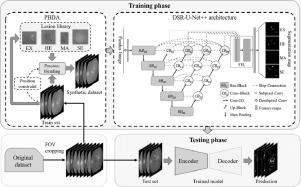Medical Image Analysis ( IF 10.7 ) Pub Date : 2022-07-10 , DOI: 10.1016/j.media.2022.102534 Hualin Wang 1 , Yuhong Zhou 1 , Jiong Zhang 2 , Jianqin Lei 3 , Dongke Sun 4 , Feng Xu 1 , Xiayu Xu 5

|
Diabetic retinopathy (DR) is one of the most important complications of diabetes. Accurate segmentation of DR lesions is of great importance for the early diagnosis of DR. However, simultaneous segmentation of multi-type DR lesions is technically challenging because of 1) the lack of pixel-level annotations and 2) the large diversity between different types of DR lesions. In this study, first, we propose a novel Poisson-blending data augmentation (PBDA) algorithm to generate synthetic images, which can be easily utilized to expand the existing training data for lesion segmentation. We perform extensive experiments to recognize the important attributes in the PBDA algorithm. We show that position constraints are of great importance and that the synthesis density of one type of lesion has a joint influence on the segmentation of other types of lesions. Second, we propose a convolutional neural network architecture, named DSR-U-Net++ (i.e., DC-SC residual U-Net++), for the simultaneous segmentation of multi-type DR lesions. Ablation studies showed that the mean area under precision recall curve (AUPR) for all four types of lesions increased by >5% with PBDA. The proposed DSR-U-Net++ with PBDA outperformed the state-of-the-art methods by 1.7%-9.9% on the Indian Diabetic Retinopathy Image Dataset (IDRiD) and 67.3% on the e-ophtha dataset with respect to mean AUPR. The developed method would be an efficient tool to generate large-scale task-specific training data for other medical anomaly segmentation tasks.
中文翻译:

泊松混合数据增强的视网膜图像异常分割
糖尿病视网膜病变(DR)是糖尿病最重要的并发症之一。DR病灶的准确分割对于DR的早期诊断具有重要意义。然而,多类型 DR 病变的同时分割在技术上具有挑战性,因为 1) 缺乏像素级注释和 2) 不同类型 DR 病变之间的巨大差异。在这项研究中,首先,我们提出了一种新的泊松混合数据增强 (PBDA) 算法来生成合成图像,可以很容易地利用它来扩展现有的病变分割训练数据。我们进行了大量的实验来识别 PBDA 算法中的重要属性。我们表明位置约束非常重要,并且一种类型病变的合成密度对其他类型病变的分割具有联合影响。其次,我们提出了一种卷积神经网络架构,名为 DSR-U-Net++(即 DC-SC 残差 U-Net++),用于同时分割多类型 DR 病变。消融研究表明,使用 PBDA 后,所有四种类型病变的精确回忆曲线下平均面积 (AUPR) 增加了 >5%。拟议的带有 PBDA 的 DSR-U-Net++ 在印度糖尿病视网膜病变图像数据集 (IDRiD) 上优于最先进的方法 1.7%-9.9%,在 e-ophtha 数据集上的平均 AUPR 优于 67.3%。开发的方法将是为其他医学异常分割任务生成大规模任务特定训练数据的有效工具。我们提出了一种卷积神经网络架构,名为 DSR-U-Net++(即 DC-SC 残差 U-Net++),用于同时分割多类型 DR 病变。消融研究表明,使用 PBDA 后,所有四种类型病变的精确回忆曲线下平均面积 (AUPR) 增加了 >5%。拟议的带有 PBDA 的 DSR-U-Net++ 在印度糖尿病视网膜病变图像数据集 (IDRiD) 上优于最先进的方法 1.7%-9.9%,在 e-ophtha 数据集上的平均 AUPR 优于 67.3%。开发的方法将是为其他医学异常分割任务生成大规模任务特定训练数据的有效工具。我们提出了一种卷积神经网络架构,名为 DSR-U-Net++(即 DC-SC 残差 U-Net++),用于同时分割多类型 DR 病变。消融研究表明,使用 PBDA 后,所有四种类型病变的精确回忆曲线下平均面积 (AUPR) 增加了 >5%。拟议的带有 PBDA 的 DSR-U-Net++ 在印度糖尿病视网膜病变图像数据集 (IDRiD) 上优于最先进的方法 1.7%-9.9%,在 e-ophtha 数据集上的平均 AUPR 优于 67.3%。开发的方法将是为其他医学异常分割任务生成大规模任务特定训练数据的有效工具。消融研究表明,使用 PBDA 后,所有四种类型病变的精确回忆曲线下平均面积 (AUPR) 增加了 >5%。拟议的带有 PBDA 的 DSR-U-Net++ 在印度糖尿病视网膜病变图像数据集 (IDRiD) 上优于最先进的方法 1.7%-9.9%,在 e-ophtha 数据集上的平均 AUPR 优于 67.3%。开发的方法将是为其他医学异常分割任务生成大规模任务特定训练数据的有效工具。消融研究表明,使用 PBDA 后,所有四种类型病变的精确回忆曲线下平均面积 (AUPR) 增加了 >5%。拟议的带有 PBDA 的 DSR-U-Net++ 在印度糖尿病视网膜病变图像数据集 (IDRiD) 上优于最先进的方法 1.7%-9.9%,在 e-ophtha 数据集上的平均 AUPR 优于 67.3%。开发的方法将是为其他医学异常分割任务生成大规模任务特定训练数据的有效工具。











































 京公网安备 11010802027423号
京公网安备 11010802027423号